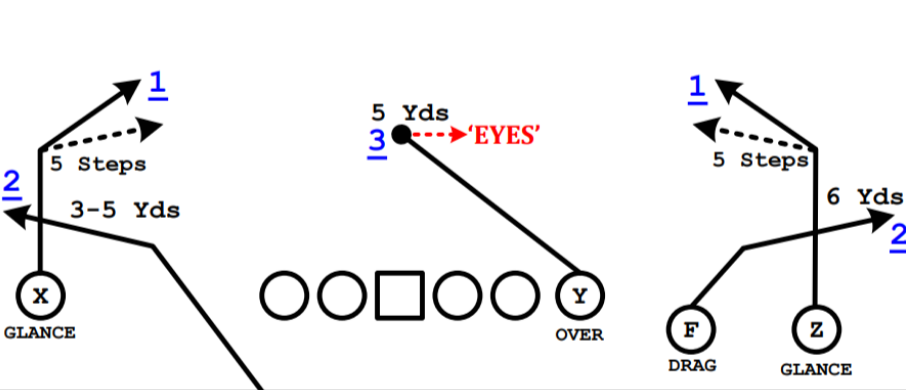
Top 10 West Coast Offense Route Combinations and Their Route Trees
The West Coast offense focuses on quick, high-percentage throws, enabling the quarterback to make fast, decisive reads. Each of these route combinations, complete with their West Coast names and route tree numbering, is crafted to exploit defensive weaknesses.
1. Dragon (Slant-Flat)
- Route Tree Number: 21
- Routes: The outside receiver (X) runs a slant (Route 2), while the slot receiver (Y) runs a flat (Route 1).
- Goal: Dragon creates a high-low read, allowing the quarterback to quickly hit a receiver in stride for yards after the catch (YAC).
2. Lion (Double Slants)
- Route Tree Number: 22
- Routes: Both the outside receiver (X) and the slot receiver (Y) run slants (Route 2).
- Goal: Lion floods the short middle of the field with quick slants, giving the quarterback multiple options to beat zone coverage or a blitz.
3. Stick
- Route Tree Number: 910
- Routes: The slot receiver (Y) runs a flat (Route 1), the tight end (T) runs a quick sit or hitch route (Route 0), and the outside receiver (Z) runs a go route (Route 9).
- Goal: Stick is a go-to concept against zone coverage, providing the quarterback with a quick, simple read to pick up consistent, small gains.
4. Smash
- Route Tree Number: 70
- Routes: The outside receiver (X or Z) runs a hitch (Route 0), while the slot receiver (Y) or tight end runs a corner route (Route 7).
- Goal: Smash is effective against zone coverage, where the quarterback can choose the short hitch if defenders stay deep or the corner route if they bite on the hitch.
5. Drive
- Route Tree Number: NA
- Routes: The inside receiver (Z or H) runs a shallow cross or in-breaking route (Route 6), while another receiver (Y) runs a deeper dig (Route 6).
- Goal: Drive floods the middle of the field at multiple depths, putting pressure on defenders and creating natural picks for receivers running across the field.
6. Mesh
- Route Tree Number: NA
- Routes: Two receivers, typically the X and Y, cross at 3-5 yards with slants (Route 2), creating natural rubs. A third option (H or T) might sit in the middle or run a wheel route.
- Goal: Mesh is highly effective in man coverage, creating natural picks or rubs, allowing receivers to get open and providing the quarterback with a quick, short-range completion.
7. Texas (Angle)
- Route Tree Number: NA
- Routes: The running back (T) runs an angle route, starting with an outside release like a flat route, then sharply breaking back inside.
- Goal: Texas isolates the running back against a linebacker, creating a favorable mismatch for easy yards in the middle of the field.
8. Hank
- Route Tree Number: 402
- Routes: The inside receiver (Y) runs a curl (Route 4), the outside receiver (X) runs a hitch (Route 0), and the running back (T) swings out as a checkdown option.
- Goal: Hank works well against zone coverage, giving the quarterback reliable options underneath coverage to pick up moderate gains.
9. Shallow Cross
- Route Tree Number: NA
- Routes: The Z receiver runs a shallow cross, while another receiver (Y or X) runs a deeper in-breaking route, like a dig (Route 6).
- Goal: Shallow Cross creates a layered approach across the field, giving the quarterback multiple levels of options.
10. Flood
- Route Tree Number: 952
- Routes: The outside receiver (X) runs a go (Route 9), the slot receiver (H) runs an out route (Route 5) at around 10 yards, and another receiver (Y) runs a crossing route to the flood side or a flat route.
- Goal: Flood targets zone coverage by stacking routes along one side, overwhelming defenders with options at multiple depths.

